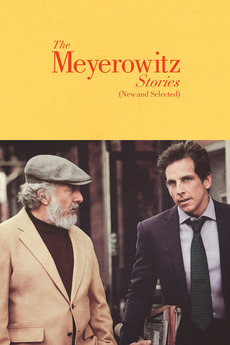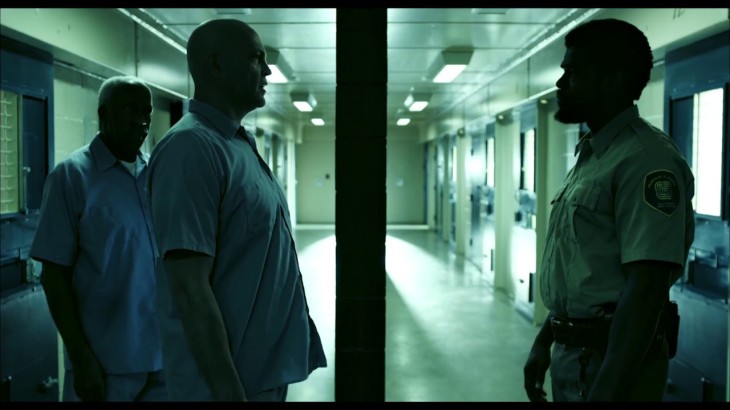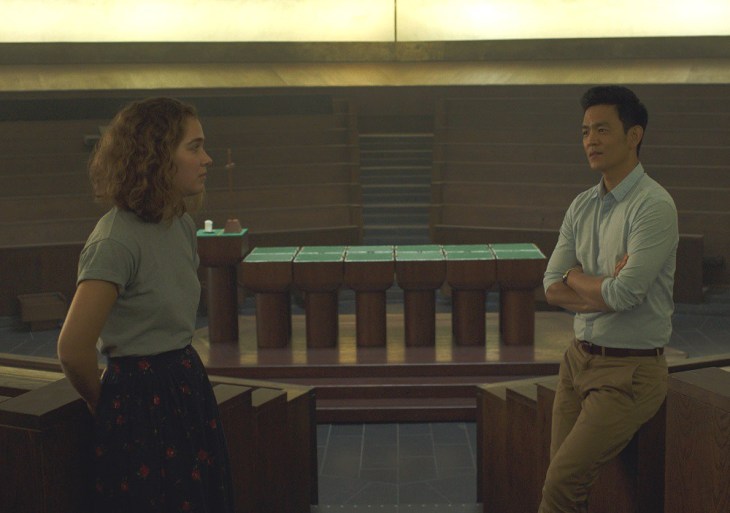Honorable mentions:
Sleep Has Her House
A haunting experimental film by Scott Barley, shot entirely on an iPhone camera. I can only describe this as a visual journey, though not in the same way as, say, The Tree of Life might be described as such. It’s much more passive and introspective and functions more as an enabling factor for diving deeper into certain emotions. Sleep Has Her House is a gorgeous work of art that leaves me curious as to what else Barley has in store.
Mayhem
Pure, unadulterated madness in cinematic form, powered by a solid central performances by Steven Yeun and Samara Weaving and some gratuitous, fast-paced and cartoonish editing a la Edgar Wright. It also serves as an interesting, if not at all subtle, commentary on corporate culture and social mobility.
The Square

An impressively stylish collection of scene concepts that doesn’t quite come together but is nevertheless absolutely intriguing in its execution and dense thematic substance. Ruben Östlund provides us with an interesting look at the smugness of the upper classes and the ridiculous nature of modern art.
Loveless (Nelyubov)

Zvyagintsev continues to reflect on wider problems within Russian society by looking at the microscopic, compartmentalized lives of individuals with unique stories and depressing realities that are concealed behind a veneer of illusions and soothing lies.
10. The Meyerowitz Stories (New and Selected)

Noah Baumbach’s Meyerowitz Stories is the movie that comes closest to mimicking and updating the style of Woody Allen of old, perfectly capturing the subdued and quietly introspective nature of works such as Manhattan and Annie Hall, while providing much more in the way of charm and loveability when it comes to the characters and their complicated relationships. It’s a perfect introduction to this style of film making for those unable or unwilling to sit through Allen’s often stomach churning performances and wishful self-inserts.
9. Last Flag Flying

Richard Linklater is a giant of American cinema and one of the few true auteurs of modern Hollywood. What is remarkable about his work is how human it is, and how precisely it manages to portray the very experience of existing, of being alive and interacting with the world around us. There is no central theme or set of ideas to be explored or analyzed, the characters are rarely aware of the answers to the questions that they ask themselves. What Linklater gives us is a glimpse into the collective world of humanity, at the fears that plague each and every one of us and of the conundrums that we are all faced with. Last Flag Flying is no different in this respect as it slowly but surely introduces us to a set of characters who have all been beaten down by their experiences in the military and are struggling to deal with the repercussions of their actions and inaction. There is no ideology to be found in this movie, no political diatribes save for those that come from places of genuine pain and anger inside the characters themselves (something that is to be expected in a work of fiction that aims to portray true people going through real struggles). There is, however, something somewhat off about Last Flag Flying’s tone, a certain glum resignation and bitterness that bleeds through at certain points in the movie. Linklater has matured and that is becoming evident in his work – the rebellious and devilishly inquisitive spirit of Slacker is more or less gone, giving this film an even more melancholy air for those who’ve followed Linklater’s career up until this point.
=8. I, Daniel Blake

Ken Loach has long been known for his politically charged movies, but few have been quite as gripping and heart-breaking as his latest outing, I, Daniel Blake. It is a story that shows the effects of austerity and cold bureaucracy on the common man and perfectly portrays the growing sense of anxiety that arises from one’s inability to cope materially and financially in a world that is more than ready to leave the weak behind at the drop of a hat.
=8. Brawl in Cell Block 99

Vince Vaughn’s immensely frightening performance put the movie on the map, but what truly made it remarkable was director S. Craig Zahler’s sure hand and reverence towards the golden days of the Brit prison and grindhouse genres that served as the main influence for the film’s aesthetic, which mainly revolves around creating claustrophobic and anxiety-inducing set pieces that always seem on the edge of exploding into a bloodbath of extremely graphic, if at times somewhat cartoony, violence. Brawl is a cold, utterly soul-crushing experience that leaves the viewer completely hopeless by the end of Vaughn’s rampage.
6. Dunkirk

There’s not much to say about Dunkirk that hasn’t already been said. I would urge any of my fellow Nolan detractors to give this film a chance as it offers all of the well-executed and choreographed thrills of his prior works but with none of the shoddy scriptwriting and laughable pretenses to intellectual or emotional depth. Dunkirk is paradoxically subdued despite the grandeur of its subject matter and it’s all the better for it, leaving the individual stories to follow one simple theme – that of survival at all costs.
5. Super Dark Times

I place Super Dark Times so high on this list first and foremost because of its chilling aesthetic and brilliant camera work that ties the film together thematically from start to finish. It is rare for first-timers like Kevin Phillips to come out with a movie that is as effective and artistic as this one, especially considering the fact that, on its surface, this movie could have turned out to be nothing more than a mediocre clone of the nostalgic small-town gimmick that Spielberg popularized years ago (though it’s amazing how Stranger Things, Netflix’ most popular series and the one that made this 80s throwback shtick mainstream, managed to somehow be even more shallow and inoffensive than Spielberg’s habitually bland turn out). Super Dark Times is absolutely chilling from start to finish, even if its final act takes a turn for the worse and the movie devolves into a slightly-above-average slasher, and that is mostly thanks to its beautifully cold color scheme, shallow focus and consistently interesting framing that makes the unfolding events incredibly frantic.
4. Columbus

Columbus is absolutely one of the most beautiful films of the year, not least because of the way it use the small town of Columbus’ unique architectural style as a means of portraying its characters’ relationship and internal struggles, but also because it feels authentic through and through. First time director Kogonada crafted a wonderfully intimate film that feels both down to earth and incredibly cinematic at the same time, and it is this very duality that turns it into a dream-like experience. Columbus is slow, methodical and, for me at least, weirdly depressing, as its characters appear stuck in time, unable to escape a town that feels like it’s inhabited by ghosts whose only job it is to hold the protagonists back, not through their actions, but through their dependence and inability to cope on their own.
3. A Ghost Story

There are few movies that portray the feeling of life slipping through one’s fingers as well as A Ghost Story does. Few movies manage to utilize the strange feeling of being an observer of another’s life and of being out of place in a certain time or space, and this very characteristic leaves the movie up for interpretation – is A Ghost Story a look at futility and a source of existential dread, or is it a meta-commentary on the nature and experience of observing art, as well as said art’s relationship to man? Either way, the film is incredibly unique, not least due to its use of the outdated Academy ratio and weird non-linear story-telling form.
2. Good Time
The Safdie brothers truly hit it out of the park with Good Time, a movie so kinetic and thrilling that it requires more than one viewing in order for one to fully appreciate the immense quality of its story. It fuses its social commentary on the reality of poverty and racial discrimination with an engrossing, fast-paced story so well that it is easy to miss one or the other and only appreciate it for whichever aspect you noticed first. And you most definitely will find something to appreciate about it, be it the unique take on New York with its flashy neon lights and dimly lit areas that give the city a personality in the same way as films like Taxi Driver use the mise-en-scene to tell a story of it own in the background, or because of Benny Safdie and Robert Pattinson’s remarkable performances (especially that of the latter who fills the screen with his presence in every scene and elevates the movie to even further heights). Good Time delivers exactly what it promises in the title.
1. It Comes at Night

This is a film that I am certain will be remembered for many years to come. It Comes at Night is the high standard for the fledgling genre of “neo-horror” and serves as a shinning example of every characteristic that the movies coming after it must bear. It relies on psychological and emotional horror rather than physical scares or threats, burrowing itself deep into the viewer’s mind and prompting him or her to always be vigilant and ready to reflect upon whatever is happening on the screen. The film’s confusing nature turns it into a fever dream that keeps deteriorating until it devolves into an absolute mess of unwanted and unexpected events that spell nothing but trouble for the protagonists. The house that the family lives in is reminiscent of the Overlook Hotel in that it never truly takes form or reveals its geography, forcing the viewer to reluctantly take the backseat and let the film steer its own course. The result is an even more profound sense of bewilderment, one that is encompasses every frame of the movie. No, It Comes at Night might not “objectively” be the best movie of the year, but it is, in my eyes, one of the most influential and important ones and will be hailed in the future as one of the parents of this new genre, right up there with The VVitch and It Follows. And it’s also the movie that I enjoyed the most this year, so there’s that as well.
